Get your dog clean the easy way with this dog soap recipe. I’ll show you how to make a homemade dog shampoo soap bar, and how we use it to clean our pup.
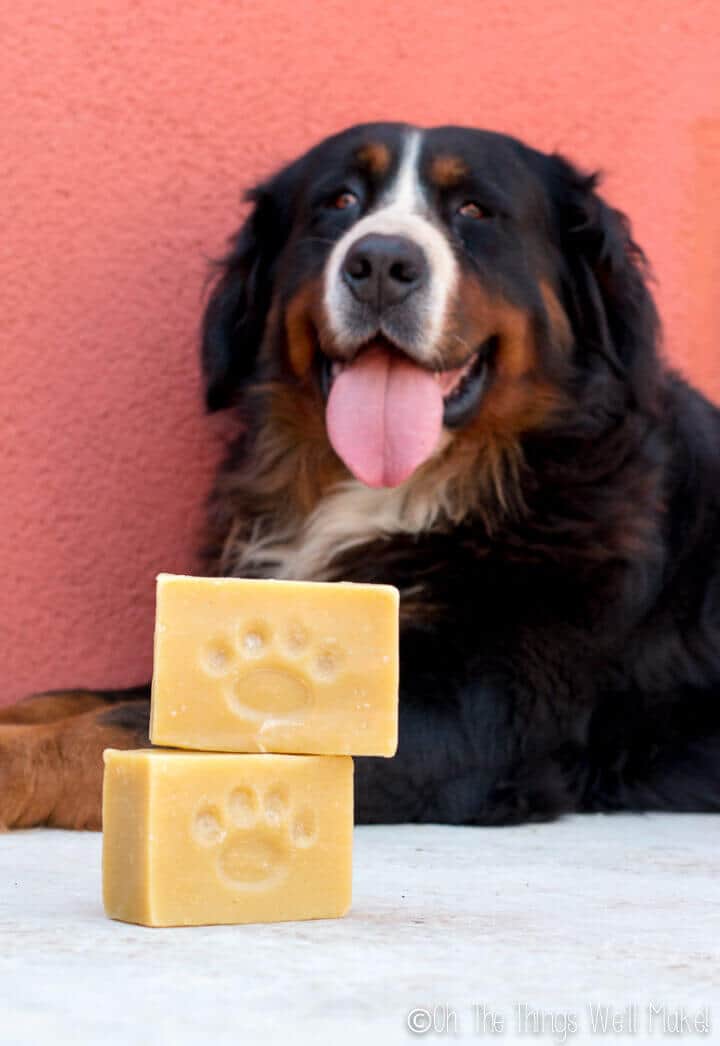
Several years ago, I started formulating a soap for bathing our dog. Despite my love of making my own bar and liquid soaps for general cleaning and bathing, I don’t use soap for my hair. In fact, I’ve been working on making a general, non-soap shampoo, and I’ll share my recipe for that soon.
On the other hand, I do love using a bar soap to bathe our dog!
Before I share my recipe for making a homemade dog shampoo (soap) bar, I’d like to share some of my reasonings, and talk about some of the myths or general beliefs people have about shampoos and soaps for both people and dogs.
Is the pH of soap good for hair?
Soap is always on the alkaline side, with a pH above 7. In fact, more often than not, the pH of soap is above 9. While I have already talked about how soap’s high pH doesn’t generally concern me when using soap for bathing, I don’t like the idea of using soap on my hair!
I have always read that our hair doesn’t react well to having an alkaline cleanser, leaving the cuticles of the hair standing and leaving hair dull looking. It can also contribute to mechanical friction between hairs leading to damage.
I was even more inclined to believe what I’ve read after trying out various “no poo” methods of cleaning my hair. I tried everything from vinegar rinses to rinsing my hair with a mixture of water and sodium bicarbonate (aka. baking soda).
Vinegar left my hair shiny, but feeling greasy and gross, and things didn’t get better with time. Baking soda, on the other hand, left my hair feeling ever worse. I ended up with hair that felt like straw and looked dull and brittle!
When fabricating “shampoo” soap bars, the soaps are normally highly superfatted to help combat some of the shortcomings of soap for hair, and help prevent some of the damage that it can cause. Even when made in that manner, I don’t think soap is ideal for making shampoo.
If I feel that soap can be damaging to hair, why would I use it on my dog’s hair?
First, let’s talk pH.
A dog’s skin is more alkaline than human skin. Their skin is said to have a pH above 7, on the alkaline side, whereas ours has a pH on the acidic side (in the 5.5 range).
It is normally said that human shampoos have a lower pH than those formulated for dogs, which should fall in a more neutral range. In fact, that’s one of the main reasons that people are often told not to use their own shampoos on their dogs.
So, you’d think that my answer is going to be that a dog’s more alkaline pH will better tolerate soap’s higher pH…
In practice, though, I don’t think that’s necessarily the case. It’s a bit of a myth that dog shampoos have a higher pH than those made for humans, and it is really more dependent upon the shampoo itself. (The last link will bring you to a study conducted by Barbara Bird, CMG, in which the pH of 60 pet shampoos were compared with 45 human shampoos. She showed a huge, overlapping range of pH value for both types of shampoos.) For a more complete version of the article, where you can see a list of the different shampoos studied, check page 12 of this PDF where the study of the pH of pet and human shampoos begins.
Barbara’s conclusion was that concerns about the pH of dog shampoos is more driven by profit than by by any real science showing the pH value to be important. (That’s sort of the way I feel about pH balanced “soaps” for human skin.)
She believed that the main reason for choosing a shampoo made for dogs rather than one for humans is that human shampoos are formulated for using several times a week or even daily. Dogs, on the other hand, are normally bathed much less often, and are probably much dirtier at the time they are bathed and will require a more cleansing shampoo.
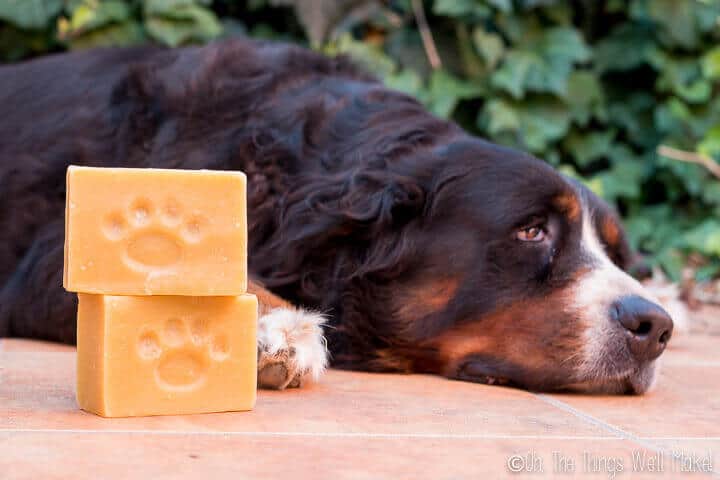
In the end, after all of my research, I couldn’t find any reason NOT to formulate a dog soap bar, so I decided to make one. (Simple as that!) You don’t want to use this or any shampoo very often on dogs because it will dry out their skin. Period.
Plus, since then, when my dog has had bouts of eczema “hot spots” on her skin, her vet has told me that the best thing to do in those areas is to clean those areas with a bar (lye processed) soap several times a day until the problem areas dry up. He didn’t seem concerned about using regular soap on a dog.
All of that said, I must reiterate that you should only be using this, just like with dog shampoos, occasionally. You shouldn’t normally bathe a dog more than once a month, at the very most! We usually bathe our dog less often than that. If a dog needs to be cleaned more often than that, because of something particular that happened one day, I’d recommend a good thorough rinsing, or a rinse with some conditioner instead, if you can get away with that. I choose to only wash with soap or shampoo more often as a last resort (or in localized areas where I’m actually trying to dry out problem areas of skin as prescribed by the vet).
In the end, I tried making my first dog soap mostly as an experiment, knowing that many people swear by using soaps on their dogs. I, too, was pleasantly surprised by how much I loved it!
Bar soap vs. Liquid soap on dogs
Being used to using liquid shampoos, I was sure that I would prefer a liquid soap for washing my dog.
I was wrong!
One of the things I tried was dissolving the pieces that I had cut off the soap to square it up into some water, and I started out by using that.
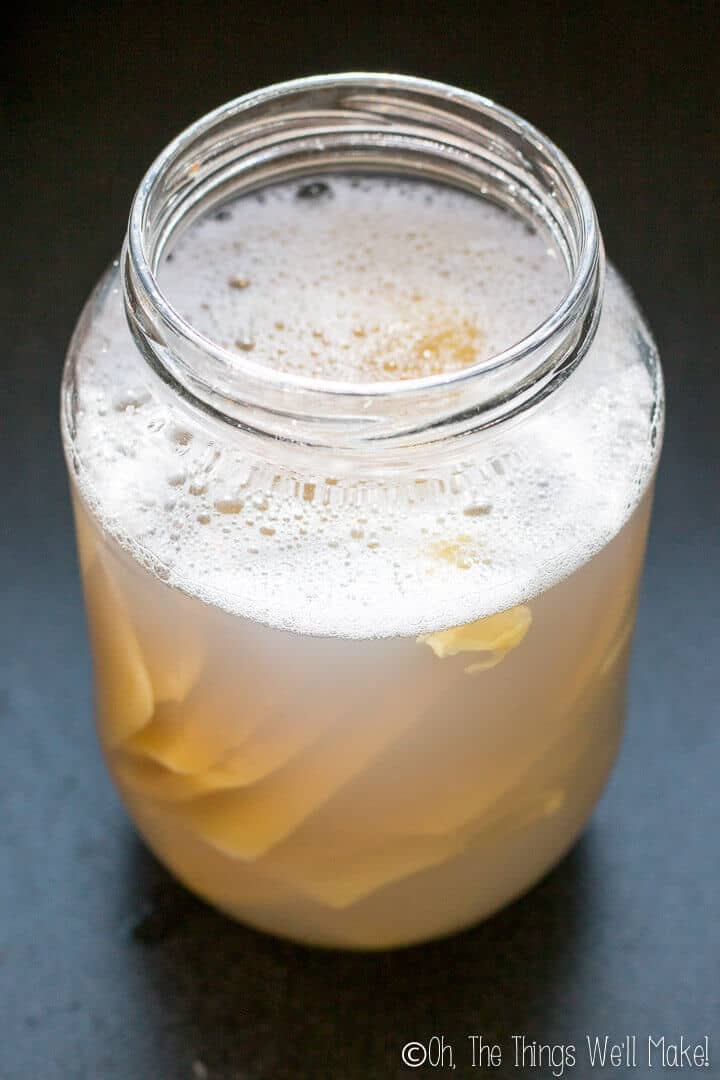
The problem? It took a heck of a lot of dissolved soap to get any lather. I was using a lot of soap and it still didn’t feel like I was getting my dog very clean.
It wasn’t a commentary on the quality of the soap. I’ve always had a similar feeling when using dog shampoos on my dog. I end up using quite a large portion of the bottle to cover all of the fur, and it’s hard to control where it all goes. If it’s liquidy, it runs all over the place and a lot is lost. If it’s thick, it’s hard to spread all over the body.
Using a bar soap is a whole other game. I purposefully made large bars of soap so that I could easily grip onto them when I wash my dog. We start out by wetting down all of her fur before proceeding to rub the bars of soap all over her coat.
I was surprised by how quickly everything lathers up, and by how easy it is to cover her entire coat with soap quickly. With a bottle of shampoo, I’m constantly trying to hold my dog in place, while trying to pour the shampoo either into my other hand or directly onto her fur. Then, trying to spread it all around is just as tricky. Using a bar of soap is so much easier to fully clean your dog!
Using a conditioner on your dog for a shiny coat
While I haven’t noticed my dog’s hair being dull after washing his hair with the soap, I like the idea of following up the soap with a bit of conditioner.
Just like with dog shampoos, there are plenty of dog conditioners on the market. I studied the ingredients of a few of them, and I honestly didn’t see much of a difference in the ingredients used. Once again, my intuition tells me that a lot of the difference is really just marketing hype.
What I would say is that it’s probably best to use a lightweight type conditioner on your dog, and one with mild ingredients, in case not all of the conditioner gets rinsed away.
That’s why I use the same lightweight DIY hair conditioner that I make for myself. It’s light enough to use as a leave in conditioner, so if any is left behind, it isn’t a problem. It uses mild ingredients, so there’s nothing that will bother my dog’s skin. In fact, I believe it’s quite nourishing. The pH was around 6 last time I checked, so it is close enough to neutral to not bother a dog’s skin, if pH is even an issue, but not alkaline, so it leaves the hair nice and shiny.
I really love using the conditioner because it helps me get out matts and tangles in my dog’s hair, all while leaving it feeling nice and soft.
Are essential oils bad for dogs?
Not all essential oils are safe for dogs, but I chose a mixture of insect repelling essential oils for this soap that are said to be safe for dogs. (As with essential oils for people, essential oils on dogs should be used diluted as it is in this soap.) I chose these particular oils to help leave behind a scent that will help keep some insects away. That’s also one of the reasons I chose neem oil for this soap.
If you don’t have all of the oils I used on hand, you can leave some out and exchange them for a combination of some of the others. Or, if you prefer, you can just leave the essential oils out altogether.
In any case, the neem oil also leaves behind a scent that will help ward of unwanted insects.
Neem oil benefits in soap
Neem oil in soap is antibacterial, antifungal, and has insecticidal properties. It’s an ideal ingredient for a soap for dogs because it can help clear up their skin conditions all while mildly keeping insects away.
Video
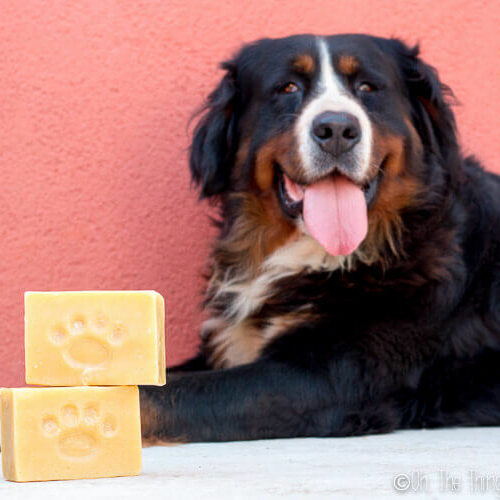
Homemade Dog Shampoo Soap
Materials
- 200 g olive oil
- 150 g coconut oil 76º
- 50 g neem oil
- 75 g rapeseed oil See notes below about possible substitutions.
- 25 g castor oil
- 190 g distilled water
- 70 g lye
- 3 g lavender essential oil
- 3 g citronella essential oil
- 3 g thyme essential oil
- 3 g peppermint essential oil
- 3 g eucalyptus essential oil
Instructions
- Put on safety goggles and gloves before working with lye. This is just a safety precaution because lye is caustic and can burn your skin.
- Weigh out the lye and water in glass, ceramic, or heavy plastic bowls.
- Add the lye to the bowl of water (and not the other way around!) in a fully ventilated area. (I usually do this step outside.)
- Mix together well the lye and water until the lye has fully dissolved. You will notice that it heats up and gets more opaque first and then it will cool down and get clearer. Leave the mixture to sit in an area where it won’t be disturbed by anybody or any animals.
- Weigh out all of the main oils (olive oil, coconut oil, neem oil, rapeseed oil, and castor oil- not the essential oils) on a kitchen scale. I find it easier to tare a large bowl and then add each oil to it, taring again between additions.
- Add the lye solution to the oil solution and gently mix together.
- Continue mixing the ingredients with an immersion blender until you reach trace. Trace is the point of making soap when the saponification process has begun. It is when the mixture gets more opaque and thicker, looking like an emulsified sauce.
- At trace, you can now add essential oils. You can either weight them out and add them, or add some and take a whiff to see how strong the fragrance is.
- Fully incorporate the essential oils into the soap mixture.
- Pour the mixture into molds. I like to use silicone loaf pans, but you can also use milk cartons, plastic containers, or, of course, soap molds. 🙂
- Cover and insulate the soap with a towel, and set it aside where it can stay undisturbed for a day or two to harden up.
- Check on the soap occasionally, and unfold it when it appears hard enough to easily unfold without breaking.
- Cut the soap into bars. For this particular use, I like to make big, chunky bars of soap that are easy to hold onto when washing our dog. They’ve worked really well for us so far!
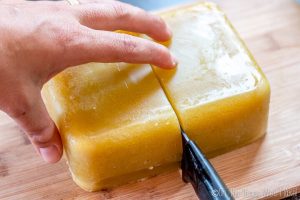
- I stamped a paw pattern into my soap, while it was still somewhat soft, using the plastic caps of items I found around the house. You can decorate your soap with soap stamps or rubber stamps or something else like I did at this point.
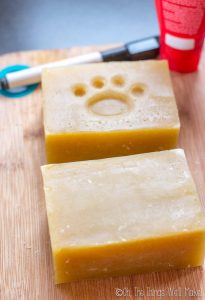
- Set the soap aside for a few weeks to dry and harden up more. While the saponification process will have completed within a couple of days and you can technically use it then, the soap will harden and improve with drying time, meaning it will also last you longer when using it.
- You are now ready to give your dog a bath! Have fun, and try not to get too wet! 🙂
Notes
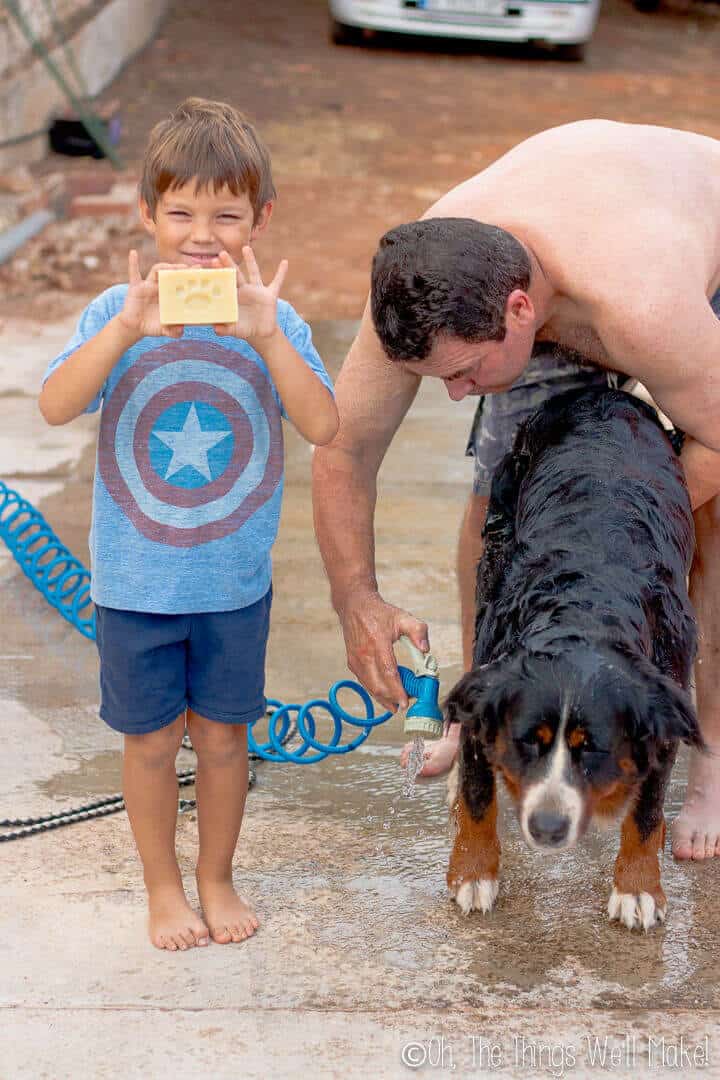
How to use the homemade dog shampoo bar soap
This is how we normally bathe our dog with this soap. My husband likes to hook up our homemade solar water heater to the hose so that we can use warm water outside. 🙂
- Brush your dog to allow for easier wetting of all of his or her fur.
- Fully wet your dog’s fur with water.
- Use the bar of soap to work up a lather all over your dog’s fur. You can optionally comb through the fur again to make sure all areas are well covered with soap.
- Rinse all of the soap from your dog’s fur.
- Now you can use some conditioner to help make brushing easier and help remove any tangles. It will also leave your dog’s fur soft and shiny.
- Comb through the fur with the conditioner in place.
- Rinse out the conditioner.
- Let your dog shake off the extra water. You can once again comb through the fur as it dries to help remove any loose fur and have your dog looking his or her best.
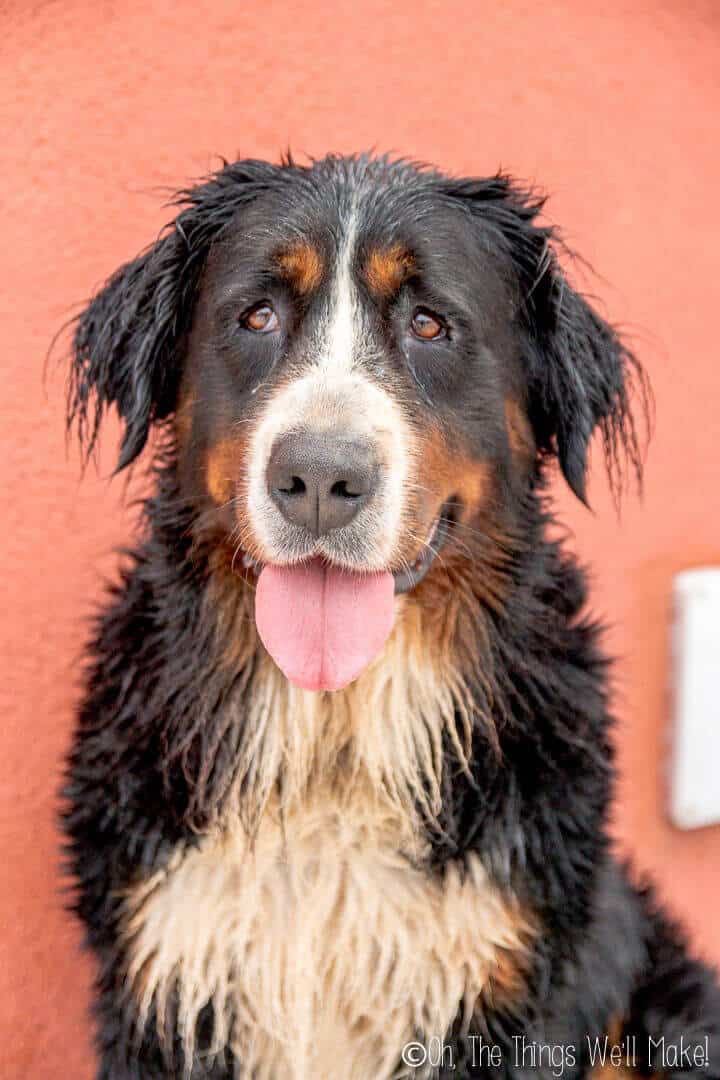
Enjoy your nice, clean, soft dog!
 Español
Español
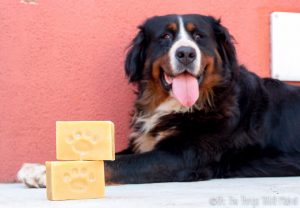

 Easy Homemade Laundry Soap From Scratch, For Beginners!
Easy Homemade Laundry Soap From Scratch, For Beginners!
Austin
Rapeseed oil is actually the same thing as canola oil in the US! If you have that in your kitchen it should work.
Melissa
What are the percentages of ingredients for this soap? Also, what is the superfat %?
Tracy Ariza, DDS
Hi Melissa,
I’m not sure what you mean by the percentages of the ingredients.
I’m guessing I probably used the default amount of 5% when formulating the recipe as that generally works well for most recipes that are similar to this one. I’d have to run it all through a lye calculator again, though, to know for sure.
Karen
Hi Tracy,
What temperatures should the lye/water solution and the oil solution be before mixing together ?
Thanks!
Tracy Ariza, DDS
Hi Karen,
I mix them together pretty much immediately when the lye solution has cleared up. (It usually gets cloudy and then clears up.) I make sure that the lye has fully dissolved and use it warm. I don’t measure the temperatures.
Over the years, I have done a lot of experiments with temperature and haven’t found it to make that much of a difference. It will take longer to reach trace when everything is cold. (And if you have butters or solid oils in the recipe, you may get a false trace with cold mixtures.) That’s why I like to use the lye solution while warm, and why I like to melt solid oils and fats before using them.
James Aripin
Hi Tracy,
Do you have the formula to make liquid dog soap? Would love to make them if you have. Thank you.
Tracy Ariza, DDS
Hi James,
I’d just use one of my regular liquid soap recipes. (This liquid soap made with coconut oil is probably my favorite now.)
You could also try my liquid shampoo if you want something with a lower pH.
Alicia
This is so great! Thank you!!
Tracy Ariza, DDS
You’re welcome!
Heidi
Citronella is toxic to pets
Tracy Ariza
Hi Heidi,
While ingesting the citronella plant is toxic, the small amount of oil used in this, a rinse-off product, isn’t enough to cause ill-effects. If it were used in high percentages, it could also cause skin irritation. In this case, though, the oil isn’t in contact with their skin for very long and it is rinsed off. That’s why it can be used at a higher percentage than it could be used in a spray or lotion.
You do want to keep your dog from eating citronella candles, plants, etc.
There are many safe citronella-based products meant for dogs.
All of that said, it is very easy to make this without citronella if you aren’t comfortable using it. The oils are there to help ward off insects and are completely optional.
Tammy
Have you ever tried this recipe with goat milk? Curious because I want to make a soap for my dogs and tend to use it in my “people soap”. I have never used any neem oil in people soap so I wasn’t sure if that might be an issue.
Tracy Ariza
Hi Tammy,
While I haven’t tried it in this particular recipe, I don’t see why there would be a problem in using it. Because you’ve already used it before in soap, I guess I don’t need to warn you about preventing it from scorching when mixing it with lye. ?
Jaspreet
Which melt and pour soap base is good to make dog soap?
Tracy Ariza
Hi Jaspreet,
I don’t have a lot of experience with melt and pour soaps as I prefer to make my own. Most melt-and-pour soaps aren’t actually true “soaps,” but are instead detergent based. Those that are true soaps tend to have additives like propylene glycol to make the soap meltable (as most natural true soaps won’t melt easily on their own). That’s why I choose to avoid them normally. There may be some exceptions, but I don’t know of them.
Iyona
Hello,
I am yet to try this recipe but I am very excited. I do have a question though. My dog has sensitive skin, it there’s a way I could add some oatmeal or anything to the mixture. Would that be safe at all? And potentially skip the essential oils or is there any oils that could be safer?
Tracy Ariza
Hi Iyona,
I suppose that is possible. You could add colloidal oatmeal or even ground oats to the soap at trace.
Also, yes, the essential oils are completely optional! Lavender is one of the mildest, so you opt to just use that one (or that and tea tree as both are very mild and also are thought to repel insects.) Plus, the combo smells good. 😉
If you find he (she?) has super sensitive skin and would like something lower in pH, perhaps I could come up with a surfactant based shampoo for dogs.
Would you be interested?
I’d also recommend using the homemade conditioner. It will help both the hair and the skin. 😉
It works wonders on my dog!
Iyona
Hi Tracey,
Thanks for your reply! Yes I might try the colloidal oatmeal and see how that goes.
A surfactant based would be great if you could 🙂 he would sure love anything that helps ease his itch.
I have all the ingredients ready to go! I hope this goes well
Thanks again
Iyona
Tracy Ariza
Sure-
I’ll add it to my list. I can’t make any promises about how quickly I’ll get to it, but it’s now officially on my “to do” list.
Good luck with it and give him a big slobbery kiss from me. 😉
Joanne M Maillet
Hi Tracy! I love this formula and interested in making & selling some to help support my senior dog sanctuary. I wanted to replace the Rapeseed oil with Sweet Almond Oil and replace the Neem oil with Avocado Oil. Would that still be ok? Also just wanted to make different batches with just 2 Essential Oils each for fragrance. Just wondering if its still 3 grams if im using just two EO? Thanks! Anything will help ?
Tracy Ariza
Hi Joanne,
I sent it throught hte lye calculator and you’d end up with a soap that’s around 6-7% superfatted. That should be fine. You could lower that by bringing the lye up to 71g for 500g of oil. (The recipe as written without adjusting it)
The essential oils are really optional. The idea is to help add scent and hopefully ward off some insects.
It’s really up to you. At lower quantities, it’s likely to lose its scent more quickly. Most essential oils don’t have a super long-lasting or potent fragrance in soap. That’s why the percentage is so high. If it’s going to be cost-prohibitive, you could ditch the oils in the soap.
I follow up the soap with my homemade conditioner. In all honesty, the essential oils go a lot further in the conditioner. They last longer and you don’t need nearly as much. If you were thinking of following up with something, you could add the oils to that- just keep the percentage much lower (1% or less) if it’s not a rinse-off product.
I add oils to my soap recipes because most people are turned off by a soap with no scent, but in reality I’m used to that and most of the time I don’t bother adding EO’s to my soaps anymore (except for the liquid soaps where the scent goes further and lasts longer).
Good luck with it. And give a big kiss to your dogs from me. A senior dog sanctuary sounds like a wonderful place. Those dogs are so lucky to have you! <3
Joanne M Maillet
Hi! Thank you so much for the quick reply! I agree on the EO theory for sure and people do want something scented so id still love to add EO in the mix. Im leaning towards a selection that doesnt have to ward off insects but smells good like lavenders, Cedarwood etc. I have 23 big dogs here so definitely can try different soaps on them for trial & error lol. I love this formula with a powerhouse of great oils. Im just wondering how many grams of EO’s total i can mix to give it a good scent and be able to sell it? I know 2 things that is a must for a good selling soap, scent and must lather good. Im going to try the follow up conditioner on my dogs but dont want to sell conditioner, just shampoo bars.
Thanks!!?
Tracy Ariza
That sounds great.
Yes, then I’d try to go up to 3% of the recipe by weight. You can experiment to find a mix you like and one that lasts longer. Lavender tends to be a good one to use and can be found fairly inexpensively. (When using for scent in a soap, you don’t really need to go for the most expensive ones, of course.)
You’ll be making much larger batches than mine, I’m sure! This batch is quite small because I only wanted to make a couple of bars for my dag. The recipe made 2 very large bars, but I cut a lot off to square them up because I had a bad mold.
For selling, I’m not sure what size bar would be ideal. I really did like the big bars for shampooing her, though. It made it really easy to hold and maneuver, and, of course, will last much longer that way.
I know you are thinking you don’t want to make conditioner, but in all honesty, it probably would give you a greater profit margin. (And I’d bet there aren’t as many for sale for dogs.) Most of the product is water so it ends up being inexpensive to make. The problem is the need for microbial testing to sell it in most countries, but the US is super lenient and as far as I know doesn’t require it. (That doesn’t mean that it’s not a good idea morally to do it so you know how long your product keeps for microbe-free.)
I bought really expensive serum for dogs once and it was basically just a conditioner. Ha!
Making soap is probably safer, so I get it. 😉
I’m curious to hear how it goes with the substitutions. Mine has a good lather so hopefully, yours will too! 🙂
Good luck!
Joanne M Maillet
Your the best! Thank you so much for all the info. I will let you know how it goes and hopefully sell some to help my sanctuary. Thank you!
Tracy Ariza
Great! Looking forward to hearing about how it goes! 🙂
Joanne M Maillet
Hi Tracy! I was just wondering by chance if you knew how much Rosemary Extract could go in your recipe of 500 g to help preserve for a longer shelf life? Thxs!
Tracy Ariza
To be honest, I’ve never used it in a soap, so I had to look it up.
I found this: “A suggested usage rate of Rosemary Extract in soap recipes is from 0.03% up to 0.10%.”
So, depending on how big of a batch you want to make, you can add up the weights of everything and figure out how much something in that range would be. and add that in.
Joanne M Maillet
Thank you!!
Tracy Ariza
Joanne- there is also the option of making a non-soap shampoo bar. I haven’t experimented with adding much fragrance to those, but I have been playing with the idea of making one for dogs too. I used mine on my dog for her last bath and it worked wonderfully too. It’s all about what it more convenient for you…
This is the basic shampoo bar recipe.
Sonia
Hi Tracy, thanks for sharing. I don’t have a dog but I’m looking for a soap that is good for horses. Do you think this one could be used on horses? PH is between 7.0 and 7.4, I think. Do I need to make any adjustments? I’d like to make a soap bar to use with one of those sisal bags. Now I use liquid shampoo and I end up using too much or dropping a lot around. There are many recipes for dogs soap bars but none for horses. Thanks for your help.
Tracy Ariza, DDS
Hi Sonia,
It should be fine.
The pH of soap is higher than that, but honestly, animals aren’t bathed enough for it to really be that big of a deal. Our skin recovers well from changes in pH, but our hair can be damaged with time. That said, animals aren’t normally bathed often enough for it to be of concern.